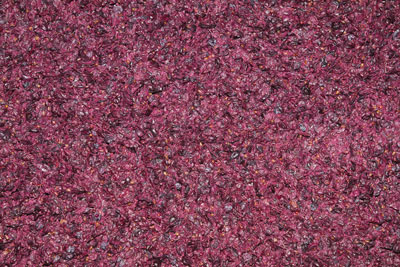There’s an ancient tradition of making wine using skins “donated” from other fermentations and projects. The one you list above is one such scenario. The most well-known incidence of this practice includes the “Ripasso” wines (which means to “re-pass”) from Italy where the dried and pressed skins of one dark red grape are used to enhance the fermentation of another, lighter wine.

Your situation seems like it’s an interesting idea. I think that the amount you choose to add should be determined by looking at the quality of the Syrah grapes in question. Indeed, my first question would be: Will the vineyard owners be picking their half for rosé a lot sooner than you might want to be making your red wine? Typically, rosé grapes are picked at a much lower Brix and higher acid than for making red wine; say about 23 °Brix and 3.4 pH. Those numbers aren’t great for red winemaking. So are you planning on coming to some compromise with them where you’ll all be happy with your initial Brix and acid balances? Otherwise, if they pick two weeks earlier than you there’s no way for them to keep those skins “fresh” and usable while you wait for your half of the vineyard to get ripe.
Let’s pretend, however, that you all decide to pick when the grapes get into red winemaking territory, say around 24.5 °Brix and 3.55 pH. I still wouldn’t be inclined to use all of the Syrah skins. I would think that adding much more than 30% would start to make it difficult for you to “work” your red fermentation, i.e., it would be really difficult to punch down/pump over (depending on your cellar setup). I would think an inclusion of about 30% to be ideal. That way you’ll benefit from the extra “oomph” provided but in case the grapes are really tannic you won’t go overboard. Let your taste buds be your guide. Do the skins taste pleasant, have great color, and are they nice and ripe? Or are they bitter, tannic, and green? The more pleasant they are the more you can increase the dose, up to a point where your must becomes too difficult to work with. It also risks adding too much tannin to your wine. If you taste your wine during fermentation and believe it is becoming too tannic, you can press the must a bit early and finish alcoholic fermentation in the next vessel minus the skins and stems so even more tannins are not absorbed.




